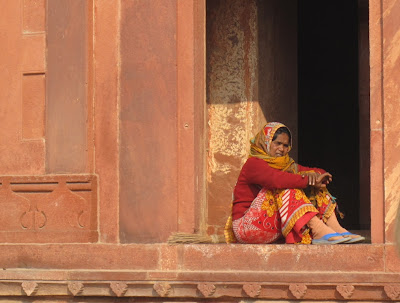Although tour manager had strenuously attempted to dissuade the party from taking the elephant ride, 6 of us were not to be put off and so we ascended the hill to the fort, lurchingly swaying from side to side on the backs of the elephants. It is just one of those things one has to do.
The forts were getting rather repetitious in their style and layout, but this one had a room that was inlaid inside and out with mirrors. Unfortunately tourists are no longer allowed inside and can only view through the doorways but the effect outside is to give the area a bluish tinge; an attempt to make the place feel cooler on the hot summer days.


From there we were taken to the obligatory “tour operator and government approved” jewellery
 manufacturing and selling establishment and on to the City Palace where there was a textile museum and an art gallery that had basically been stripped of its art works. After lunch at the cafe there, we crossed the road to the Observatory, completed in 1734.
manufacturing and selling establishment and on to the City Palace where there was a textile museum and an art gallery that had basically been stripped of its art works. After lunch at the cafe there, we crossed the road to the Observatory, completed in 1734.The observatory is an incredibly fascinating place with a massive sundial accurate to 2 seconds; built after the smaller one, accurate to 20 seconds, was deemed insufficient. A well as huge structures to measure the inclination of the sun, there are a range of structures used for astrology as this is very important in Hindu culture. All of these were reliant on the sun to work and for the brief time we were there the sun was shining, enabling us to see them in operation.
Besides these, there were many other “instruments” for celestial observations and since the stars were not out we could only read about them and imagine it.
The afternoon was rounded off with a visit to the Bapu Bazaar to try our hand at bargaining for trinkets.





















































